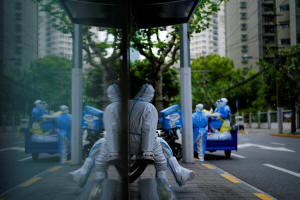Shanghai marks COVID milestone, Beijing on edge
 Send a link to a friend
Send a link to a friend
 [April 30, 2022]
By Brenda Goh and Min Zhang [April 30, 2022]
By Brenda Goh and Min Zhang
SHANGHAI/BEIJING (Reuters) -Shanghai said
on Saturday it had detected no new daily COVID-19 cases outside
quarantine areas, marking a milestone in its battle to contain the
virus, which has paralysed the city of 25 million and put residents in
the capital Beijing on edge.
Streets in Beijing were eerily quiet at the start of a five-day Labour
Day break, with residents anxious that authorities would impose further
restrictions during a holiday when many typically travel or socialise.
"You look at a city that used to be crowded and now is void. You wonder
how these people manage to survive," said Li, 35, who works in the
finance sector in Beijing, breaking into tears.
In the eastern commercial capital of Shanghai, scenes of houses and
buildings ringed with fences to prevent residents from leaving have
grabbed headlines at a time when most other countries in the world are
learning to live with COVID.
China maintains a zero-COVID policy aimed at eradicating the disease,
leading to frustration, especially in Shanghai, where many residents
have been cooped up for more than a month. Some, struggling to find food
and other daily necessities, have shown rare public opposition to the
government's stringent controls.

If the zero-tolerance campaign works, however, it would be a victory for
President Xi Jinping's approach in a year when he is expected to secure
a precedent-breaking third term.
Shanghai officials did not discuss the break in COVID transmission at
their daily news conference, but social media cheered the news.
"Shanghai has finally reached zero at the community level!!! May
Shanghai wake up as soon as possible!!," said one post on the Weibo
platform.
Friday's zero cases outside quarantine areas in Shanghai compared to 108
for Thursday. Some, however, played down the milestone, noting that most
of the city's residents were locked in some form of quarantine.
On Saturday, health authorities said there were close to 16,000
sealed-off areas in Shanghai, with more than 4 million people prevented
from leaving their homes. A further 5.4 million people were blocked from
leaving their compounds.
In practice, many of the remaining residents in low-risk prevention
areas are still not allowed to leave their compounds.
"The city's epidemic and prevention control is currently still at a
critical state, and the trend is still that people need to strengthen
controls," said Zhao Dandan, deputy director of Shanghai's health
commission.
ECONOMIC IMPACT
The battle to curb the highly transmissible Omicron variant in Shanghai
has come at a high cost for the economy, with logistic chains gummed up
by the restrictions.
China's factory activity in April shrank at the fastest rate in 26
months to the lowest since the early months of the pandemic, first
detected in central China, as lockdowns halted industrial production and
disrupted supply chains. The data released on Saturday raised fears of a
sharp slowdown in the second quarter that will weigh on global growth.
[to top of second column]
|

A worker in a protective suit keeps watch at a bus station during
lockdown, amid the coronavirus disease (COVID-19) pandemic, in
Shanghai, China, April 30, 2022. REUTERS/Aly Song

Shanghai officials, who say they are eager for
factories to get back to work, said more than 80% of 666 prioritised
companies had restarted production and that they had drawn up a
second list of 1,188 firms.
Infections are easing as China enters the Labour Day break, which
runs through Wednesday, traditionally one the busiest tourist
seasons.
Some observers say authorities have been less strict in making
people take tests in recent days. But Beijing's local government
said residents must provide nucleic acid test results before going
to public places or taking public transport, effective after the
holiday break.
Theme parks and entertainment venues in the capital are only
permitted to operate at half capacity over the Labour Day holiday
with advance reservations required.
Beijing will also implement a further two rounds of COVID tests on
May 1 and May 3 in its most populous district of Chaoyang, known for
its night life, malls and embassies.
The city will halt all restaurant dining between May 1 and 4, an
official from the local commerce bureau said, calling for residents
to "cook at home".
Officials have provided no timeline or strategy for returning to
some semblance of normality.
Nomura estimates 46 cities are in full or partial lockdowns,
affecting 343 million people. Societe Generale estimates that
provinces experiencing significant restrictions account for 80% of
China's economic output.
In response to COVID and other headwinds, China will step up policy
support for the economy, a top decision-making body of the Communist
Party said on Friday, lifting stocks from two-year lows.

Shanghai reported 47 COVID-19 deaths for Friday, down from 52 a day
earlier. Some have questioned the fatality rate, as many residents
have said relatives or friends have died after catching coronavirus
as early as March.
Beijing has reported 295 new COVID-19 cases since April 22, the
local health authority said, of which 123 cases were found in the
Chaoyang district.
Overall, mainland China reported 10,793 daily COVID-19 cases, down
from 15,688 new cases a day earlier, the National Health Commission
said on Saturday.
(Reporting by Brenda Goh in Shanghai, Min Zhang and Xu Jing in
Beijing; Writing by Anne Marie Roantree; Editing by William Mallard
and Ros Russell)
[© 2022 Thomson Reuters. All rights
reserved.]
This material may not be published,
broadcast, rewritten or redistributed.
Thompson Reuters is solely responsible for this content. |